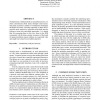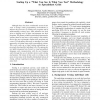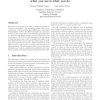29 search results - page 1 / 6 » What You See Is What You Get: on Visualizing Music |
ISMIR
2005
Springer
13 years 10 months ago
2005
Springer
Though music is fundamentally an aural phenomenon, we often communicate about music through visual means. The paper examines a number of visualization techniques developed for mus...
VL
1998
IEEE
13 years 9 months ago
1998
IEEE
We introduce visual graphs as an intermediate repren between concrete visual syntax and abstract graph syntax. In a visual graph some nodes are shown as geometric figures, and som...
VL
1999
IEEE
13 years 9 months ago
1999
IEEE
Although there has been considerable research into ways to design visual programming environments to improve the processes of creating new programs and of understanding existing o...
ICSE
1998
IEEE-ACM
13 years 9 months ago
1998
IEEE-ACM
Form-based visual programming languages, which include commercial spreadsheets and various research systems, have had a substantial impact on end-user computing. Research shows, h...
ICRA
2003
IEEE
13 years 10 months ago
2003
IEEE
We propose an approach for a robot to imitate the gestures of a human demonstrator. Our framework consists solely of two components: a Sensory-Motor Map (SMM) and a View-Point Tra...



